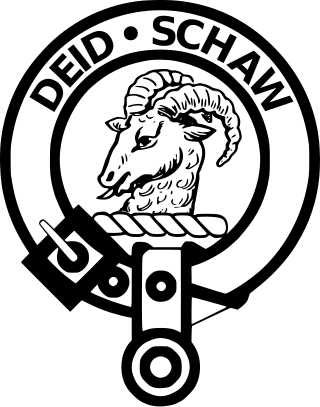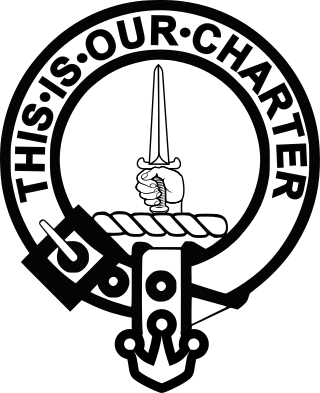
Clan Robertson, is correctly known as Clan Donnachaidh ( Duncan ) (Scottish Gaelic: Clann Dhònnchaidh) is a Scottish clan. The principal surnames of the clan are Robertson, Reid and Duncan but there are also many other septs.

Sir Rupert Iain Kay Moncreiffe of that Ilk, 11th Baronet,, Chief of Clan Moncreiffe, was a British Officer of Arms, historian and genealogist.

The Clan Ruthven is a Lowland Scottish clan.

Clan Cameron is a West Highland Scottish clan, with one main branch Lochiel, and numerous cadet branches. The Clan Cameron lands are in Lochaber, and within their lands lies Ben Nevis, the highest mountain in the British Isles. The Chief of the clan is customarily referred to as simply "Lochiel".

Clan Murray is a Highland Scottish clan. The chief of the Clan Murray holds the title of Duke of Atholl. Their ancestors were the Morays of Bothwell who established the family in Scotland in the 12th century. In the 16th century, descendants of the Morays of Bothwell, the Murrays of Tullibardine, secured the chiefship of the clan and were created Earls of Tullibardine in 1606. The first Earl of Tullibardine married the heiress to the Stewart earldom of Atholl and Atholl therefore became a Murray earldom in 1626. The Murray Earl of Atholl was created Marquess of Atholl in 1676 and in 1703 it became a dukedom. The marquess of Tullibardine title has continued as a subsidiary title, being bestowed on elder sons of the chief until they succeed him as Duke of Atholl.

Clan MacFarlane is a Highland Scottish clan. Descended from the medieval Earls of Lennox, the MacFarlanes occupied the land forming the western shore of Loch Lomond from Tarbet up-wards. From Loch Sloy, a small sheet of water near the foot of Ben Vorlich, they took their war cry of Loch Slòigh.

Clan Charteris is a Scottish clan of the Scottish Lowlands.

Clan Maclachlan, also known as Clan Lachlan, Clann Lachainn (Argyll), and Clann Lachlainn, is a Highland Scottish clan that historically centred on the lands of Strathlachlan on Loch Fyne, Argyll on the west coast of Scotland. The clan claims descent from Lachlan Mor, who lived on Loch Fyne in the 13th century, and who has left his name upon the countryside he once controlled: places such as Strathlachlan, Castle Lachlan and Lachlan Bay. Tradition gives Lachlan Mor a descent from an Irish prince of the O'Neill dynasty, Ánrothán Ua Néill, son of Áed, son of Flaithbertach Ua Néill, King of Ailech and Cenél nEógain, died 1036. Clan Maclachlan has been associated with other clans, such as Clan Lamont, Clan Ewen of Otter, Clan MacNeil of Barra, and the MacSweens: as all claim descent from Anrothan O'Neill who left Ireland for Kintyre in the 11th century. From this descent the clan claims a further descent from the legendary Niall Noigíallach, High King of Ireland, who lived from the mid 4th century to the early 5th century.

Clan Leask is a Scottish clan.

Clan Haldane is a Lowland Scottish clan.

Clan Wemyss is a Lowland Scottish clan.

The Much Honoured is an honorific style applied to various minor nobles in Scotland, including Scots barons.
The Hon. Peregrine David Euan Malcolm Moncreiffe, later Moncreiffe of that Ilk, Baron of Moncreiffe and Easter Moncreiffe and Chief of Clan Moncreiffe, is the second son of Sir Iain Moncreiffe of that Ilk, 11th Baronet Moncreiffe and Diana Denyse Hay, 23rd Countess of Erroll. He is also the younger brother of Sir Merlin Sereld Victor Gilbert Hay, 12th Baronet Moncreiffe, 24th Earl of Erroll and Chief of Clan Hay.

Clan Pringle is a Lowland clan from the Scottish Borders.
There have been three baronetcies created for people with the surname Moncreiffe or Moncreiff, two in the Baronetage of Nova Scotia and one in the Baronetage of the United Kingdom. Two of the titles are dormant, as the heir has not proved his descent, and one is extant, though its holder does not bear the surname of Moncreiffe.
Before the Acts of Union 1707, the barons of the shire of Perth elected commissioners to represent them in the unicameral Parliament of Scotland and in the Convention of the Estates. The number of commissioners was increased from two to four in 1690.

Moncreiffe House is a country house near Bridge of Earn in Perthshire in Scotland. It is a category B listed building.

Lord Kinfauns is a title of nobility and baronial rank granted in 1487 by King James III of Scots and granted anew in 1608 by King James I of Great Britain, France and Ireland.

















